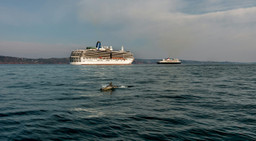
An increasing clamor: The rise of anthropophony
In ‘Silence Is Falling: The Loss of Nature Sounds’, Earth.fm recently addressed some of the reasons why field recordists are documenting decreases in the vocalizations of birds, insects, mammals – both terrestrial and marine – fish, and other ocean-dwellers. But not only are these species falling silent, the sounds they produce are being replaced.
The outside world was once characterized by birdsong; the fluttering of bats’ wings; the bellows, snorts, and growls of mammals; the assorted whistles, croaks, barks, and grunts of anurans; and the buzzes, chirps, and squeaks of insects. Now, “the loudness of humans is taking over the planet”, from the noise of traffic, planes, and boats to that of industrial processes like open-pit mining.
Why is this a bad thing?
From the calls of animals (biophony) to “whistling wind, cascading water, rustling leaves and splitting glaciers” (geophony), the natural world is loud. But the encroachment of human sounds (anthropophony) throws those naturally occurring sounds out of balance. Animals’ vocalizations aren’t ornamental; they serve key functions such as claiming and defending territory, warning of danger, locating mates, and keeping in contact with family or social groups. Not being able to make themselves heard therefore poses an existential threat to animals: without being able to breed, or avoid danger, or by becoming lost and therefore vulnerable to predators, animals die as a direct result of human noise.
Human noise can even “block […] or alter […] the natural movements of animals”, cause them to adapt their calls, and affect their use of scent (increasing danger from predators). More specifically, the reason many frogs and insects vocalize en masse in a chorus is, as soundscape-ecology godfather Bernie Krause puts it, to “inhibit […] predators from locating any single place from which sound emanates”. If, say, a plane passes overhead, causing a disruption among a previously unified chorus, predators are provided with an opportunity to locate individuals before their calls can once again become part of a homogeneous blanket of sound.
Elsewhere, in marine ecosystems, humpback whales stop singing when exposed to the disruptive noise of ships, dolphins are having to make their calls simpler to compete with human undersea noises, and coral reefs degraded by pollution and increasing temperatures are falling silent. Once a source of some of the loudest sounds in the oceans, they attracted fish which relied on these aquatic oases for food, shelter, breeding grounds, and nurseries. Marine anthropophony can even cause the deaths of marine life like whales, crabs, or squid.

From a human perspective, sound is one of the key ways in which we relate to our surroundings, “giv[ing] us a deeper understanding of place” – but they are also key to our understanding of ecological health. Listening to nature sounds “can reveal the unseen dynamics of the living world”. The loss of nature sounds, then, not only reflects a habitat’s loss of health, but denies us the insights that could have been gleaned from them.
Why are human-caused noises increasing?
One reason relates to the physical outcomes of climate-change warming. Scientific journal PeerJ reports that, because of the ways that “temperature and acidity of the water affect how easily or difficult [sic] sound travels through the ocean”, increasing greenhouse gas emissions mean “that underwater sound will travel further in the future in most parts of the oceans”.
This will see a 7 decibel (dB) increase in certain parts of the ocean by the end of the present century – an increase which corresponds to “almost five times as much noise energy under water”. Not only this, but the amount of ships will likely increase, compounding the ramifications of the noise generated by them and by other underwater sources including seismic surveys. “Potentially profound effects” caused by this impediment to the communication and survival of fish and cetaceans (whales, dolphins, and porpoises) will have severe consequences for the entire marine ecosystem.
On land, monocultures, where natural spaces have been cleared and managed to provide food or generate profit, “are acoustically bland and anemic compared to the vigor and lush sonic variegations of a forest abounding in diverse life”. These sort of plantations therefore also drive a rise of circumstances in which the primacy of human sound is unchallenged.

What about the effect on people?
The link between nature sounds and our own health and wellbeing is becoming increasingly understood. Exposure to anthropogenic noise pollution “increase[s] stress levels, disturb[s] sleep, exacerbate[s] cardiovascular disease and even cause[s] cognitive impairment in children” – with a typically disproportionate effect on marginalized and low-income demographics. (On the other hand, the revitalizing effect of natural soundscapes is equivalently beneficial.)
If we can understand that the noise we produce has such manifestly negative impacts on our own health, it shouldn’t be a stretch to appreciate that those effects extend to other lifeforms. (Animals’ stress levels, for example, can be dramatically increased by exposure to noise.) Admittedly, this requires an acceptance that more-than-human life is also sentient and receptive to its environment – which, it’s sadly evident, is not a given among those responsible for producing or legislating against environmentally damaging forces.
Another effect the erosion of nature sounds may have is to sever our connection to the world that produces them. If sound is “an emotional bridge to place”, then without it our reasons for being connected to nature itself declines. A loss of biophony risks creating a feedback loop where people feel they have less reason to care about the natural world, and further hasten its decline by failing to support it. As writer and biologist David George Haskell states, our lives are “embedded in systems designed to turn our attentions away from the voices of the living Earth, inward toward the human”. On this basis, the loss of nature sounds not only demonstrates the consequences of our impacts upon the natural world, but is consequential in and of itself.
So what can be done?
The song of the Kauaʻi ʻōʻō, a Hawaiian honeyeater bird, or the bark-like mating call of the Panamanian Rabbs’ fringe-limbed treefrog “will never again ring through forests”; they and the other species we have driven extinct will never be heard again. But there is hope for those that remain.

Playing back the sounds of healthy coral reefs is helping to encourage fish back to degraded reefs, AI can detect illegal logging by sound, while archives of natural soundscapes, such as Earth.fm’s, help to maintain and increase our connection to the natural world via its sonic properties. At the same time, scientists study soundscapes to establish “the conservation action needed to prevent further species decline and restore the health of our ecosystems”. By opening our ears to the natural world and supporting these initiatives, there is still hope that future generations will continue to fight for this cause.
Featured image by Oleg Laptev on Unsplash
Earth.fm is a completely free streaming service of 1000+ nature sounds from around the world, offering natural soundscapes and guided meditations for people who wish to listen to nature, relax, and become more connected. Launched in 2022, Earth.fm is a non-profit and a 1% for the Planet Environmental Partner.
Check out our recordings of nature ambience from sound recordists and artists spanning the globe, our thematic playlists of immersive soundscapes and our Wind Is the Original Radio podcast.
You can join the Earth.fm family by signing up for our newsletter of weekly inspiration for your precious ears, or become a member to enjoy the extra Earth.fm features and goodies and support us on our mission.
Subscription fees contribute to growing our library of authentic nature sounds, research into topics like noise pollution and the connection between nature and mental wellbeing, as well as funding grants that support emerging nature sound recordists from underprivileged communities.

